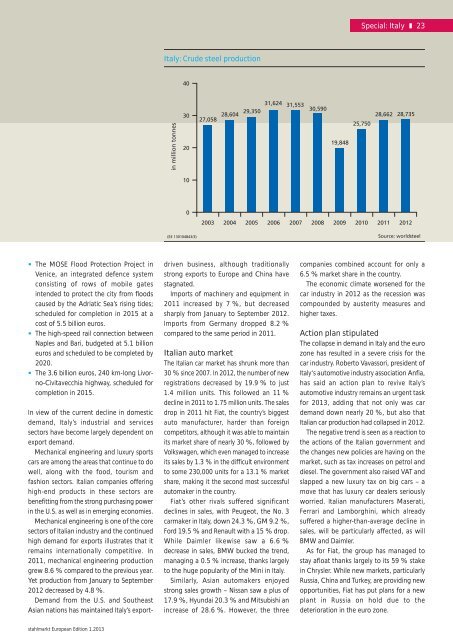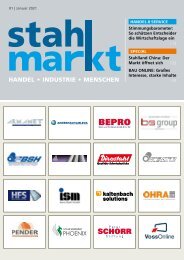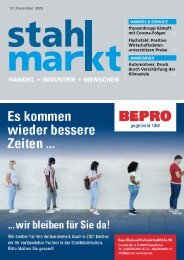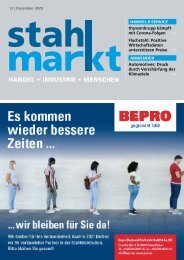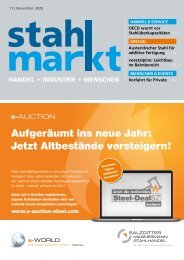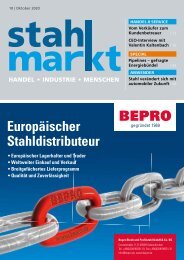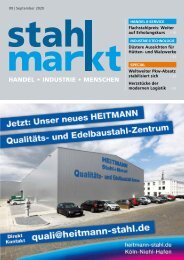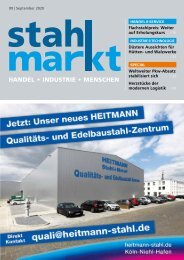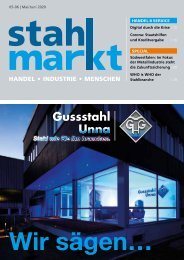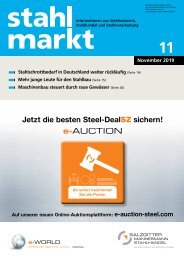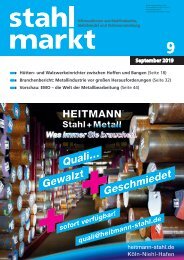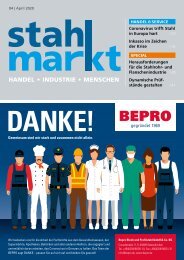stahlmarkt European Edition 01.2013
- No tags were found...
You also want an ePaper? Increase the reach of your titles
YUMPU automatically turns print PDFs into web optimized ePapers that Google loves.
Special: Italy K 23<br />
Italy: Crude steel production<br />
40<br />
in million tonnes<br />
30<br />
20<br />
27,058 28,604 29,350 31,624 31,553 30,590<br />
19,848<br />
25,750<br />
28,662 28,735<br />
10<br />
0<br />
(EE 130104843/3)<br />
2003 2004 2005 2006 2007 2008 2009 2010 2011 2012<br />
Source: worldsteel<br />
The MOSE Flood Protection Project in<br />
Venice, an integrated defence system<br />
consisting of rows of mobile gates<br />
intended to protect the city from floods<br />
caused by the Adriatic Sea’s rising tides;<br />
scheduled for completion in 2015 at a<br />
cost of 5.5 billion euros.<br />
The high-speed rail connection between<br />
Naples and Bari, budgeted at 5.1 billion<br />
euros and scheduled to be completed by<br />
2020.<br />
The 3.6 billion euros, 240 km-long Livorno-Civitavecchia<br />
highway, scheduled for<br />
completion in 2015.<br />
In view of the current decline in domestic<br />
demand, Italy’s industrial and services<br />
sectors have become largely dependent on<br />
export demand.<br />
Mechanical engineering and luxury sports<br />
cars are among the areas that continue to do<br />
well, along with the food, tourism and<br />
fashion sectors. Italian companies offering<br />
high-end products in these sectors are<br />
benefitting from the strong purchasing power<br />
in the U.S. as well as in emerging economies.<br />
Mechanical engineering is one of the core<br />
sectors of Italian industry and the continued<br />
high demand for exports illustrates that it<br />
remains internationally competitive. In<br />
2011, mechanical engineering production<br />
grew 8.6 % compared to the previous year.<br />
Yet production from January to September<br />
2012 decreased by 4.8 %.<br />
Demand from the U.S. and Southeast<br />
Asian nations has maintained Italy’s exportdriven<br />
business, although traditionally<br />
strong exports to Europe and China have<br />
stagnated.<br />
Imports of machinery and equipment in<br />
2011 increased by 7 %, but decreased<br />
sharply from January to September 2012.<br />
Imports from Germany dropped 8.2 %<br />
compared to the same period in 2011.<br />
Italian auto market<br />
The Italian car market has shrunk more than<br />
30 % since 2007. In 2012, the number of new<br />
registrations decreased by 19.9 % to just<br />
1.4 million units. This followed an 11 %<br />
decline in 2011 to 1.75 million units. The sales<br />
drop in 2011 hit Fiat, the country’s biggest<br />
auto manufacturer, harder than foreign<br />
competitors, although it was able to maintain<br />
its market share of nearly 30 %, followed by<br />
Volkswagen, which even managed to increase<br />
its sales by 1.3 % in the difficult environment<br />
to some 230,000 units for a 13.1 % market<br />
share, making it the second most successful<br />
automaker in the country.<br />
Fiat’s other rivals suffered significant<br />
declines in sales, with Peugeot, the No. 3<br />
carmaker in Italy, down 24.3 %, GM 9.2 %,<br />
Ford 19.5 % and Renault with a 15 % drop.<br />
While Daimler likewise saw a 6.6 %<br />
decrease in sales, BMW bucked the trend,<br />
managing a 0.5 % increase, thanks largely<br />
to the huge popularity of the Mini in Italy.<br />
Similarly, Asian automakers enjoyed<br />
strong sales growth – Nissan saw a plus of<br />
17.9 %, Hyundai 20.3 % and Mitsubishi an<br />
increase of 28.6 %. However, the three<br />
companies combined account for only a<br />
6.5 % market share in the country.<br />
The economic climate worsened for the<br />
car industry in 2012 as the recession was<br />
compounded by austerity measures and<br />
higher taxes.<br />
Action plan stipulated<br />
The collapse in demand in Italy and the euro<br />
zone has resulted in a severe crisis for the<br />
car industry. Roberto Vavassori, president of<br />
Italy‘s automotive industry association Anfia,<br />
has said an action plan to revive Italy’s<br />
automotive industry remains an urgent task<br />
for 2013, adding that not only was car<br />
demand down nearly 20 %, but also that<br />
Italian car production had collapsed in 2012.<br />
The negative trend is seen as a reaction to<br />
the actions of the Italian government and<br />
the changes new policies are having on the<br />
market, such as tax increases on petrol and<br />
diesel. The government also raised VAT and<br />
slapped a new luxury tax on big cars – a<br />
move that has luxury car dealers seriously<br />
worried. Italian manufacturers Maserati,<br />
Ferrari and Lamborghini, which already<br />
suffered a higher-than-average decline in<br />
sales, will be particularly affected, as will<br />
BMW and Daimler.<br />
As for Fiat, the group has managed to<br />
stay afloat thanks largely to its 59 % stake<br />
in Chrysler. While new markets, particularly<br />
Russia, China and Turkey, are providing new<br />
opportunities, Fiat has put plans for a new<br />
plant in Russia on hold due to the<br />
deterioration in the euro zone.<br />
<strong>stahlmarkt</strong> <strong>European</strong> <strong>Edition</strong> 1.2013


